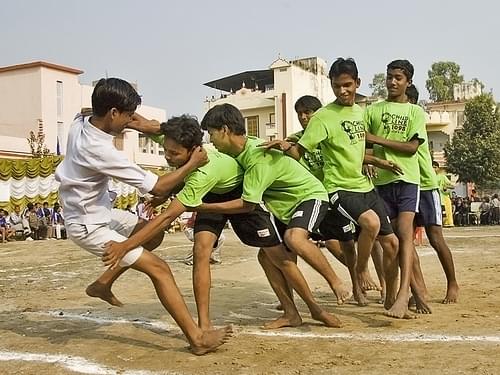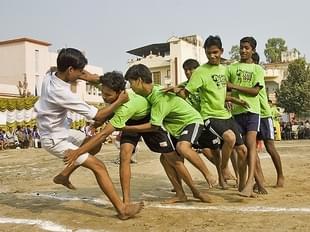Commentary
Explaining Indian Sports Weakness through Economics
Prashant Kulkarni
Aug 06, 2014, 01:18 AM | Updated Apr 29, 2016, 12:44 PM IST
Save & read from anywhere!
Bookmark stories for easy access on any device or the Swarajya app.



Every sports season, every major multi-disciplinary event, every soccer world cup becomes an opportunity to resume the seemingly never ending debate on India’s inability to emerge as sports power. Not that Indians are sports averse, few countries can match Indians’ craze for sports. Competitions particularly at college and school level are keenly contested even today. Yet there is little headway in achieving a place at the higher echelons of the sports pyramid.
For all the talk of demographic dividend and economic opportunities, barring perhaps cricket (and hockey in yesteryears when the game was played on grass), India’s strength in sports remains confined to the fringes. Creditable performances often are exception to the rule than a norm. Under-performance is so prevalent even minor medals at continental/regional games make big news. Reasons range from esoteric claims like Indians having natural aversion to violent sports (for long this was stated reason for India not producing fast bowlers!) to viewing sports as luxury good and thus not a priority in poverty hit India.
Review of Explanations Offered
Arguably, in recent years, technology has more than supplemented natural talent. Millions of dollars spent on designing sports shoes, swimsuits, sports clothing, equipment, playing surface, dietary supplements, etc act as testaments to this. P.T. Usha’s 1984 experience or instances of weightlifters losing medals on bodyweight suggest that even one hundredth of a second or one gram in body weight respectively does make difference between glory and despair at the highest levels. India’s decline in hockey is directly correlated to the switchover from grass to artificial turf and scarcity of artificial turf in India even today. Yet this thesis per se has limitations.
African dominance of long distance running, Caribbean dominance of sprint running and even cricket for quite long time, good performances by Pacific islands like Fiji and Samoa in rugby all are sufficient pointers to the limitations of technological supremacy translating to improved performances. Many of these countries are economically impoverished and thus affording technologies is beyond their reach.
A persuasive argument believes cricket is responsible directly or indirectly for the state of affairs of other sports in India. Cricket receives disproportionately large share of attention both monetary and non monetary affecting the rest of the sports. No doubt, argument commands some merit but a wide gap does exists between international and domestic players The advent of Indian Premier League (IPL) may have improved the fortunes of domestic players but the gap between international stars and domestic players apparently is as wide as ever. Moreover, experiences in other countries too indicate the presence of the ‘80-20’ rule in sports.
In other words, 80% of the attention and rewards from sports are cornered by 20% of the sports and the rest 80% struggle to meet their ends. In the US too, disproportionate attention is lavished on sports like American football, Baseball etc which are played by even fewer countries than cricket. Possibly soccer’s domination is complete in countries like Germany, France, Brazil etc. Yet these countries perform consistently well across stream of sports in multi-discipline sports events like Olympics etc.
State encouragement too is believed to enhanced performances. This version of sports Marxism got reinforced thanks to impressive performances by erstwhile Soviet Union and its East European satellites and also China in more recent times. Further, the relative fall in performance standards by East European countries in particular post 1990 scenario buttresses the point. In the cold war, sports events provided perfect opportunity to demonstrate their superiority over their Western rival’s thus becoming source of national pride.
Probably it was an occasion to hype up patriotic pride neutralizing dissenting voices on the political economic and social horizon. Patriotism notwithstanding, sports has remained in the domain of the individual with little state support and yet found success in number of countries including US, Britain, Japan, Australia etc.
Cultural factors like entrenched sports culture evident in Australia does not pass muster since both rural and urban India offer ample opportunities for folk sports and local variants of mainstream sports as part of festival and cultural celebrations. Despite sports attracting participation at junior and sub junior levels, the fact they not get translated into successes at continental and world level has to be pondered with.
An Alternative Explanation
Consider an individual’s decision to pursue sports as a career. Barring minor exceptions, sports offers short shelf life. Rewards earned for the investment tends to come in even shorter period when the athlete is at his/her peak. Besides, these rewards have to take care their post retirement life. At any given point, there is a threat of injury ruining their potential career. Besides, the rewards are not uniformly distributed over the pyramid. Apparently rewards are skewed towards those at the apex of the pyramid. Further, only a miniscule manages to reach this apex.
It is not unusual to find players on subsistence wages at the bottom of the pyramid. In addition, the probability of making successful living diminishes at every failure. Limited skill-sets deter possible career shifts. A rational agent in a prospective sportsperson would make them take hard look at cost benefit analysis of career in sports.
A sportsperson has to allocate time, money and other resources to sports and trade off with loss of time, money, family sacrifices etc. There is an element of opportunity cost. The choice of either opting for sports or an alternative career both generates certain benefits while carrying certain costs. Further there are constraints in terms of resources available for investment for a career in sports or otherwise. These costs, benefits and constraints are all subject to fluctuations. In the exercise of career choice, comparison of relative cost-benefits is inevitable subject to the resource constraints.
Optimally, the last currency unit spent on career progression in each domain yields the same increment in probability of moving up the ladder in the pyramid. Assume the last currency unit spent for career in sports yields higher increments in upward movement relative to alternative careers like engineering, technology, medicine, law, management etc; the agent will shift some resources towards sports from the alternatives like engineering, management etc. till the ratios get equalized across domains and vice versa.
Assume the costs of pursuing career in sports increases relative to the available alternatives. Implied in real terms is the agent becoming poorer in terms of resources available for investment. The outcome is investment increases on alternative career options with corresponding decline in investment in sports. This cycle of readjustment against sports as a career induces a movement towards alternatives in what economists would term as substitution effect.
For a prospective Indian sportsperson, the evaluation of career choices might not come easy. Yet given the uncertainty in a career in sports might make the costs higher. Further there is plethora of options available with greater stability, security and durability. These actually reduce the costs of pursuing careers in fields diverse from engineering to medicine to law to science etc. It is not that pursuing sports has become dearer but it is cheaper to pursue other alternative options. Implied the resource constraints for investment in these careers have eased out in real terms.
This in turn results in a movement from sports towards alternative options. When easier alternatives have become lucrative why pursue career in sports might well confront a prospective sportsperson. Such scenarios makes the athlete shift more resources towards non-sports career options and this reallocation of resources would continue till benefits per last currency spent get equalized across both sports and non-sports option. This may perhaps explain that interest in sports is high but mainly as recreation/hobby and not as serious career pursuit. This probably makes an average Indian aspire to go to US on an IT /engineering/management education/assignment rather than sports scholarship.
For his/her African counterpart, running is inherent to life and source of income. Growing up in an economically deprived society, an individual would more look at options that enhance his/her chances of improvements in standard of living. Running provides that opportunity. Examining the basket of options for African prospective sportsperson, he/she would readjust his/her resources which fetch higher benefits on the last currency unit spent on the basket.
Unlike India, cost increase in pursuing alternative career options (opportunities are limited) tightens the resource constraints in real terms marking a movement towards possibly sports (running) as career. The outcome would be reallocation of resources towards sports from other alternatives thus potentially looking for US or European visa through sports scholarship. This reasoning would equally apply for sprinters in Caribbean islands, soccer players in Latin America or rugby players in Pacific Islands.
Thus it is not per se technology, culture, emphasis on single sport, state power that drives sports power but relative attractiveness of sports vis a vis other careers in that particular economy drives the sports as career choice. An Indian might be interested in IT job in US whereas for Kenyan, NCAA sports scholarship would offer the same attraction. The bottom line suggests it makes good economic sense to invest in sports in the context of Africa, Caribbean etc given the relative cost benefits.
In India, economic sense and thus cost benefit analysis makes non-sports options less costly relative to sports given the level of benefits. This perhaps explains backwardness in Indian sports. This explanation might possibly be extended to analyze the sporting prowess of the Western World or even Russia, China etc.
Prashant Kulkarni teaches economics, a digital economy and globalization at a leading B-School. His area of interest lies in dissecting resource contestations and human behavior at the intersections of digitization, urbanization and globalization.





